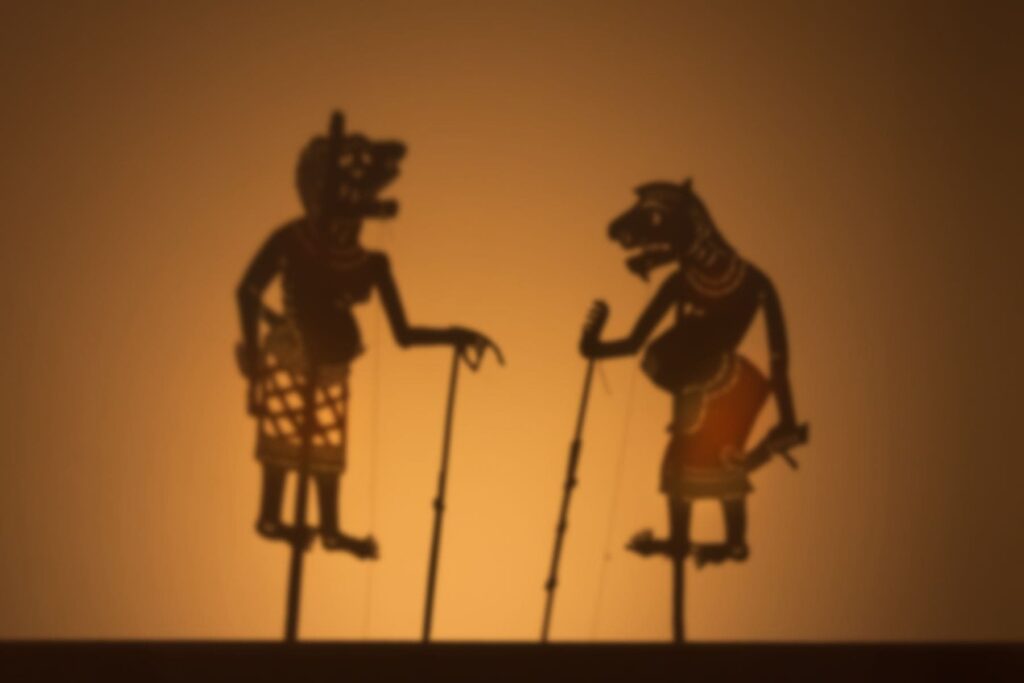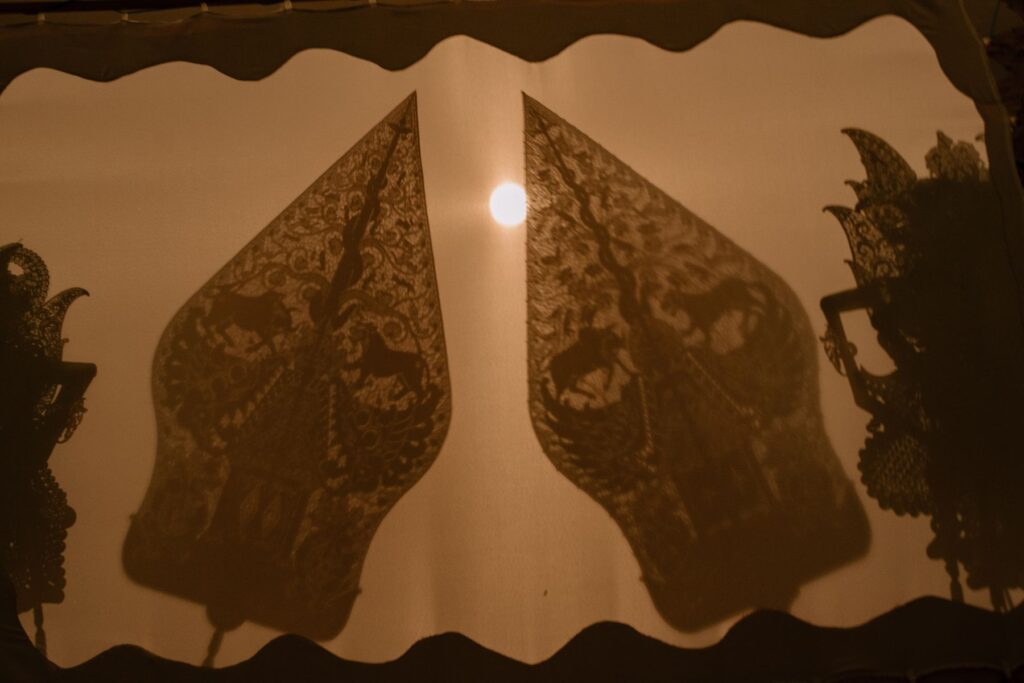WORKSHOPS
GET IN TOUCH
Step Into the World of Shadow Puppetry
Shadow puppetry, also known as shadow play, is an ancient form of storytelling and visual performance that uses flat, articulated figures—known as shadow puppets—to create the illusion of moving images. These figures are held between a light source and a translucent screen. The result is a dance of silhouettes, often accompanied by music, narration, and sound effects. Rooted in centuries-old traditions, shadow puppetry has played a key role in the cultural, religious, and social storytelling of many civilizations.


Ancient Beginnings
The earliest recorded instance of shadow puppetry comes from China during the Han Dynasty (206 BCE – 220 CE). According to legend, the art form began when Emperor Wu of Han was grief-stricken by the death of his concubine. A minister created a lifelike silhouette of her using stretched donkey hide, bringing her “back to life” through shadows. While this tale is largely mythological, it highlights the powerful emotional and symbolic role shadow puppetry played in early Chinese society.
From these beginnings, shadow puppetry flourished in Asia. It spread to India, Indonesia, Thailand, and beyond—often adapting to local traditions and spiritual beliefs.
Global Spread
In India, shadow puppetry developed independently, with traditions like Tholu Bommalata in Andhra Pradesh and Togalu Gombeyaata in Karnataka. These performances drew heavily from Hindu epics like the Ramayana and Mahabharata, using puppets made of painted leather.
In Indonesia, shadow puppetry became Wayang Kulit, a spiritually infused performance recognised by UNESCO as a Masterpiece of Oral and Intangible Heritage. The puppeteer, or dalang, holds a revered status, acting as both narrator and spiritual guide.
Shadow puppetry also reached the Islamic world, particularly Turkey and Egypt. In the Ottoman Empire, it manifested as the comedic Karagöz and Hacivat shows, blending slapstick, satire, and morality. European cultures, including Greece, Italy, and France, adopted the form too—although often as children’s entertainment or experimental theatre.
Construction and Performance
Making the Puppets
Traditional shadow puppets are crafted from animal hide (usually buffalo or goat skin) or stiff paper. Artisans etch intricate designs and often paint the puppets with bright colours, even though the audience only sees the silhouette. In some regions, colour does show faintly through the screen, adding nuance to the performance.
Puppets typically feature movable arms, legs, and heads, controlled by rods or strings. This articulation allows them to simulate lifelike gestures and combat sequences.
Performance Setup
A typical shadow puppetry stage involves a backlit screen made of white cloth, with a light source (originally oil lamps, now often electric bulbs) positioned behind the puppets. The puppeteer stands behind the screen, manipulating the puppets while narrating the story or voicing multiple characters.
Many performances are accompanied by live music. In Indonesia, a gamelan orchestra provides dramatic tension and mood. In India, percussion instruments like the mridangam or tabla add rhythm to the storytelling. Sound effects—using bells, chimes, or even everyday objects—enhance the immersive experience.
Regional Traditions and Styles
China – Piyingxi
Chinese shadow puppetry, or Piyingxi, is among the oldest and most refined forms. Puppets are usually made of translucent leather and are dyed with natural pigments. Performances often depict historical events, Confucian morals, or popular legends like Journey to the West.
Traditionally performed in temples and village squares, Piyingxi blends music, singing, and dialogue, with puppeteers sometimes voicing dozens of characters. The visual aesthetics are intricate, with puppet details cast in fine shadows.
Indonesia – Wayang Kulit
Indonesia’s Wayang Kulit is deeply intertwined with religion and philosophy. Puppets are elaborately carved and gilded, representing gods, demons, kings, and clowns. The dalang performs behind a screen, using a single lamp as a symbolic representation of divine light.
The stories often come from Hindu epics or Javanese folklore. Unlike Western theatre, performances can last through the night and are considered meditative or spiritual experiences. The dalang must master years of training in language, philosophy, music, and performance.
India – Tholu Bommalata and More
India has multiple shadow puppetry traditions, each reflecting local language and customs. Tholu Bommalata (Andhra Pradesh), Togalu Gombeyaata (Karnataka), Chaya Nataka (Odisha), and Ravanachhaya are just a few examples.
These performances are usually religious and seasonal, held during festivals or temple events. Puppets are made of colourful leather, and the narratives focus on mythology, moral lessons, or social teachings.
Thailand – Nang Yai and Nang Talung
Thai shadow puppetry divides into two forms. Nang Yai uses large, non-articulated puppets, sometimes over a metre tall. The performances are grand and ceremonial. Nang Talung, by contrast, uses smaller, movable puppets for more informal storytelling.
Thai shadow puppetry often includes elements of dance, with performers moving in sync with the puppets, creating a hybrid of visual and live art.
Turkey – Karagöz and Hacivat
Turkish shadow play centers around Karagöz, a comical, blunt character, and Hacivat, his educated foil. Their dialogues reflect social satire and political commentary. Unlike the spiritual tones of Asian forms, Karagöz and Hacivat is humorous and accessible, making it a popular entertainment for both adults and children.
Performed during Ramadan and festive seasons, these shows feature fast-paced dialogue and improvisation, with puppets made of camel hide.
Themes and Storytelling
Shadow puppetry adapts to a wide array of storytelling traditions. In most cultures, performances draw from:
- Religious epics: e.g., Ramayana, Mahabharata, Journey to the West
- Folk tales and legends: heroic journeys, moral trials, cautionary tales
- Political satire: especially in Turkish and modern Asian performances
- Education and ethics: used to teach virtues, history, and social norms
Despite being rooted in tradition, many shadow puppetry narratives evolve to reflect current issues, such as environmental concerns, modern relationships, and social justice.
Cultural Significance
Shadow puppetry isn’t merely entertainment—it holds deep cultural value. It has served as:
- A medium of oral tradition, preserving myths and histories over generations
- A spiritual conduit, especially in regions where puppeteers are seen as shamans or priests
- A community event, bringing people together for collective experiences
- An educational tool, transmitting religious, moral, and social lessons
Because of its rich cultural and historical value, various shadow puppetry traditions are protected by national governments and international bodies. UNESCO recognizes several forms, including Indonesia’s Wayang Kulit and Turkey’s Karagöz.
Notable Figures and Institutions
Famous puppeteers have helped sustain and innovate the art. In Indonesia, Ki Ledjar Subroto was a renowned dalang and teacher. In China, troupes like the Tangshan Shadow Puppet Theatre preserve centuries-old techniques.
Modern institutions and museums also play a key role. Examples include:
- The Indonesian Puppet Museum (Jakarta)
- China Shadow Puppet Museum (Shaanxi)
- International Puppetry Institute (France)
These organizations offer training, performances, and archives for future generations.
Modern Adaptations
Shadow puppetry continues to evolve. In the 20th and 21st centuries, artists and filmmakers began blending traditional shadow techniques with modern technology.
Multimedia Integration
Digital projection and animation have expanded shadow puppetry’s possibilities. Companies like Manual Cinema in the U.S. create hybrid performances using overhead projectors, live actors, and animation.
In cinema, shadow puppetry has inspired sequences in films such as:
- The Fall (2006)
- Hero (2002)
- The Tale of the Princess Kaguya (2013)
Experimental Theatre and Education
Theatre groups use shadow puppetry to address contemporary issues like climate change, war, or migration. Schools integrate it into curriculum to teach history, art, and storytelling.
Shadow puppetry also appears in visual arts, with installations and performances at art festivals, galleries, and biennales.
Preservation and Challenges
While shadow puppetry retains its cultural significance, it faces serious challenges:
- Urbanization and modern entertainment have reduced live audience attendance.
- Aging practitioners struggle to find successors in traditional crafts.
- Lack of funding limits the ability of troupes to tour or adapt.
To counter these trends, many governments and NGOs support training programs, apprenticeships, and festivals. Digital archives are also being developed to document and preserve scripts, puppet designs, and performance recordings.
Shadow puppetry is a testament to humanity’s creativity and need to tell stories. Whether performed in the heart of a Javanese village, a Chinese opera house, or a Turkish coffeehouse, the art continues to inspire awe and connection. While the medium is ancient, its adaptability ensures that shadow puppetry remains relevant today—as a cultural treasure, a performance art, and a living tradition.